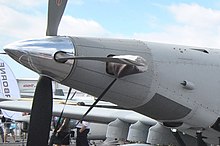General Electric H-Series
| H-Series | |
|---|---|

| |
| Let L-410NG H85 installation | |
| Type | Turboprop |
| National origin | Czech Republic/United States |
| Manufacturer | GE BGA Turboprops |
| First run | 2009 |
| Major applications | Thrush Model 510 Let L-410NG Technoavia Rysachok |
| Developed from | Walter M601 |
The General Electric H-Series is a family of turboprop aircraft engines produced by GE BGA Turboprops. The initial H80 is an updated derivative of the Walter M601, while the H75 and H85 are later derivatives.
Development

The H80 was launched in 2009 based on the M601. GE added a new compressor, blisks, blades and new stators to enhance power by 3% and boost efficiency by 10%.[1] It reaches 597 kW (801 hp) (shaft horsepower) from the M601-F's 580 kW (780 hp),[2] and improves hot and high performance.
The H80 was certificated by EASA at 13 December 2011, followed by the FAA at 13 March 2012.[3] Its Russian type certificate was received in October 2012, and the engine also approved by Brazilian Civil Aviation agency (ANAC) and the Argentine Administración Nacional de Aviación Civil.[4]
Its Electronic Engine and Propeller Control (EEPC) system received EASA type certification in late 2016. The Diamond Dart 550 military trainer is due to fly it in early 2018 and it will be certified on the Thrush 510G crop duster in this year.[1]
Design
The two-shaft, reverse flow design is derived from the Walter M601: its core features a two-stage axial and single-stage centrifugal compressor, an annular combustor and a single turbine stage, and its propulsion section is powered by a single-stage turbine driving a two-stage planetary gearbox. GE redesigned the compressor with 3D aero to improve its pressure ratio and upgraded the hot section and turbine stages with modern metal alloys for higher temperatures with the same durability.[5]
The H75-100 weighs 94 lb (43 kg) more than the equivalent PT6 but pioneers single lever electronic propeller and engine control in general aviation, for an initial TBO of 4,000 hr which could be increased with experience.[5] It promises 10% better fuel burn, 10% longer overhaul and lower maintenance costs than the PT6A-135 for the Nextant G90XT.[6]
Variants

- H80
- formerly the M601H-80
- H75
- 750 shp or 550 shp derivatives[7]
- H75-A
- 550 shp derivative with aerobatic modifications[8]
- H85
- 850 shp derivative
Applications

- CAIGA Primus 150 (H85)
- Diamond Dart 550 (H75-100)
- Dornier Do-28 G92 (H75-200)[9]
- Let L-410 Turbolet UVP-E20 (H80-200) and L-410NG (H85)
- Nextant G90XT (H75-100)[10]
- Technoavia Rysachok (H80)[11]
- Thrush Model 510 (H80)
Specification (H80)
| Variant | H75 | H80 | H85 |
|---|---|---|---|
| Dimensions (L×W×H) | 1,670×560×580 mm (66×22×23 in) | ||
| basic dry | 390 lb (180 kg) | ||
| Compressor[13] | 2-stage axial + 1-stage centrifugal | ||
| Combustor[13] | Annular with fuel slinger | ||
| turbine[13] | 1-stage axial gas.gen + 1-stage axial power | ||
| fuel type | Jet-A/A1 | ||
| Shaft power | 751 hp (560 kW) | 800 hp (597 kW) | 850 hp (634 kW) |
| Eq. shaft power | 795 hp (593 kW) | 845 hp (630 kW) | 898 hp (670 kW) |
| Power-to-weight ratio | 1.93 | 2.05 | 2.18 |
| gas gen. RPM | 35,524 | 35,854 | 36,183 |
| Shaft RPM | 2,080 | ||
| airflow | 8.1 lb (3.7 kg)/s | 8.2 lb (3.7 kg) | 8.4 lb (3.8 kg) |
| TBO | 4,000 h | ||
| Overall pressure ratio | 6.7:1[14] | ||
See also
Related development
Comparable engines
Related lists
References
- ^ a b Guy Norris (Mar 19, 2018). "GE Sees Catalyst As Engine For Change In Turboprop Push". Aviation Week & Space Technology.
- ^ "Type Certification Data Sheet" (PDF). Type Certification Data Sheet. EASA. 12 September 2017.
- ^ "U.S. FAA Certified GE Aviation's H80 Turboprop Engine" (Press release). GE Aviation. March 14, 2012.
- ^ "GE Aviation's H80 Turboprop Engine Gains Its Russian Type Certification" (Press release). GE Aviation. October 8, 2012.
- ^ a b Fred George (Dec 21, 2017). "H75-100 Turboprop Resembles The Walter/Motorlet M601 Powerplant". Business & Commercial Aviation.
- ^ Fred George (Jan 26, 2018). "Nextant G90XT Pilot Report: GE Czech, Nextant Transform King Air". Business & Commercial Aviation.
- ^ "GE Aviation Launches Two New H80 Turboprop Engine Derivatives". GE Aviation. 2012-07-23. Archived from the original on 22 October 2012. Retrieved 12 October 2012.
- ^ "GE's H-Series aerobatic engine powers its first flight on the Diamond DART-550". GE Aviation. 2020-12-10. Retrieved 10 December 2020.
- ^ "Do28 engine conversion". Gomolzig Aircraft Services GmbH.
- ^ "G90XT" (PDF). nextantpacific.com. Retrieved 4 September 2015.
- ^ "Technoavia Purchases GE's H80 Engines for New Rysachok Aircraft" (Press release). GE Aviation. February 28, 2011.
- ^ "GE H Series Turboprop Engine" (PDF). GE Aviation. Nov 2017.
- ^ a b c "GE's H-Series Engine". GE Aviation.
- ^ Daly, Mark (2015). Jane's Aero-Engines 2016-2017. London: Ihs Jane's.
